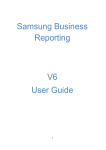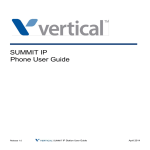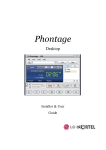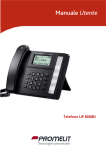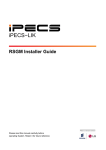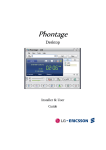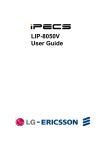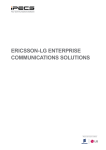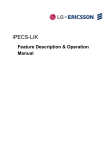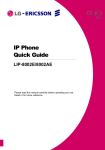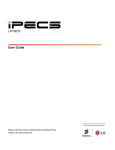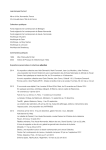Download LIP-8002E User Guide - Nine One One Communication Supply
Transcript
LIP-8002E/8002AE User Guide Please read this manual carefully before operating Phone. Retain it for future reference. LIP-8002E/2AE User Guide Revision History Issue 1.0 1.1 1.2 Date Dec. 2011 Oct. 2012 Dec. 2013 Remark Initial Release Changed CI to Ericsson-LG Changed Ericsson-LG to Ericsson-LG Enterprise Disposal of your old appliance 1. When the crossed-out wheeled bin symbol is attached to a product, it means the product is covered by the European Directive 2012/19/EC. 2. All electrical and electronic products should be disposed of separately from the municipal waste stream via designated collection facilities appointed by government or the local authorities. The correct disposal of your old appliance will help prevent potential negative consequences for the environment and human health. 4. For more detailed information about disposal of your old appliance, please contact your city office, waste disposal service or the shop where you purchased the product. Copyright© 2011 Ericsson-LG Enterprise Co., Ltd. All Rights Reserved. This material is copyrighted by Ericsson-LG Enterprise Co., Ltd. Any unauthorized reproductions, use or disclosure of this material, or any part thereof, is strictly prohibited and is a violation of Copyright Laws. Ericsson-LG Enterprise reserves the right to make changes in specifications at any time without notice. The information furnished by Ericsson-LG Enterprise in this material is believed to be accurate and reliable, but is not warranted to be true in all cases. iPECS is trademarks of Ericsson-LG Enterprise Co., Ltd. All other brand and product names are trademarks or registered trademarks of their respective companies. LIP-8002E/2AE User Guide Important Safety Information To prevent unexpected danger or damage please read this information before installing or attempting to repair you phone. Warning and Caution information is provided to alert the consumer of known dangers: Warning: To reduce the possibility of electric shock, do not expose your phone to high humidity areas, such as a bathroom, swimming area, etc. Caution: Use only Ericsson-LG Enterprise approved batteries and desktop chargers to avoid the damage to the phone. Using other batteries or chargers voids your warranty and may cause an explosion. 1. 2. 3. 4. 5. 6. 1. Only trained and qualified service personnel shall install, replace or service the phone. Do not spill liquid life water on the phone. If so, call the service center as this may result in fire or electric shock. If you see smoke or smell something during use, unplug the power cord and the phone line. Call the service center immediately. If the power adapter is used, do not touch the plug with wet hands. This may result in a fire or an electric shock or equipment damage. Do not use the phone during a thunderstorm. Lightning strike may result in fire, severe electrical or acoustic shock. Do not use the power adapter if the power cord or wall outlet is damaged. This may result in fire or an electric shock. Ensure that children do not pull on phone cords. This may injure children or result in equipment damage. 2. The ear-piece houses a magnetic device which may attract pins or small metal objects. Keep headset clear of such objects and check before use. 3. Avoid placing the phone in an area that is excessively dusty, damp or subject to vibration. 4. Choose a site for the phone that is well-ventilated and dry. 5. Do not plug multiple plug-packs into one power outlet. This may result in the plug overheating and may result in a fire or plug pack failure. 6. Do not put heavy things on the phone. 7. Do not drop or throw the phone. 8. Static electricity discharge will damage electronic components. 9. Keep out of direct sunlight and away from heat. 10. No user-serviceable parts inside. Do not insert a screwdriver or any metal objects into the phone. This may cause electric shock or damage the equipment and will render the warranty void. 11. Clean the phone with a soft, dry cloth only. Do not use volatile liquids such as petrol, alcohol, or acetone as this may cause a fire or result in discoloration or damage to plastics. Do not clean with wax or silicon products as these may enter the equipment and cause operation to become unstable. LIP-8002E/2AE User Guide [EU] European Union Declarations of Conformity Ericsson-LG Enterprise Co., Ltd. declare that the equipment specified in this document bearing the “ CE” mark conforms to the European Union Radio and Telecommunications Terminal Equipment Directive(R&TTE 1999/5/EC), including the Electromagnetic Compatibility Directive(2004/108/EC) and Low Voltage Directive(2006/95/EC). Copies of these Declarations of Conformity (DoCs) can be obtained by contacting your local sales representative. [USA/CSA] FCC/IC Interference Statement This equipment has been tested and found to comply with the limits for a Class B digital device, pursuant to part 15 of the FCC Rules. These limits are designed to provide reasonable protection against harmful interference in a residential installation. This equipment generates, uses and can radiate radio frequency energy and, if not installed and used in accordance with the instructions, may cause harmful interference to radio communications. However, there is no guarantee that interference will not occur in a particular installation. If this equipment does cause harmful interference to radio or television reception, which can be determined by turning the equipment off and on, the user is encouraged to try to correct the interference by one or more of the following measures: Reorient or relocate the receiving antenna. Increase the separation between the equipment and receiver. Connect the equipment into an outlet on a circuit different from that to which the receiver is connected. Consult the dealer or an experienced radio/TV technician for help. This device complies with part 15 /RSS-GEN of the FCC/IC rules. Operation is subject to the following two conditions: (1)This device may not cause harmful interference; and (2) This device must accept any interference received, including interference that may cause undesired operation. This Class B digital apparatus complies with Canadian ICES-003. Cet appareil numérique de la classe B est conforme à la norme NMB-003 du Canada. The use of this device in a system operating either partially or completely outdoors may require the user to obtain a license for the system according to the Canadian regulations. CAUTION : Any changes or modifications in construction of this device which are not expressly approved by the party responsible for compliance could void the user's authority to operate the equipment. LIP-8002E/2AE User Guide Table of Contents 1. INTRODUCTION ................................................................................................. 1 1.1 1.2 1.3 1.4 1.5 GENERAL ................................................................................................................................................... 1 FEATURE INFORMATION ....................................................................................................................... 1 FEATURE GROUPINGS .......................................................................................................................... 1 IPECS LIP-8002E/2AE PHONE DESCRIPTION ....................................................................... 2 LIP-8002E/2AE PHONE INSTALLATION ...................................................................................... 3 1.5.1 1.5.2 1.5.3 Wiring Connectors ......................................................................................... 4 Power ............................................................................................................ 4 Wall Mount ..................................................................................................... 4 2. RECEIVING CALLS.......................................................................................... 5 2.1 2.2 2.3 2.4 2.5 2.6 ANSWERING A CALL W HILE IDLE ..................................................................................................... 5 RESPONDING TO A CALL W HILE BUSY .......................................................................................... 5 DIFFERENTIAL RING SIGNALS ........................................................................................................... 6 ANSWERING CALLS TO OTHER STATIONS ................................................................................... 7 USING DO-NOT-DISTURB (DND) TO BLOCK INCOMING CALLS .......................................... 8 FORWARDING CALLS............................................................................................................................ 8 2.6.1 2.6.2 2.6.3 Forwarding calls to another station or Voice Mail ........................................... 8 Forwarding calls to an external number.......................................................... 9 Forwarding callers to a Text Message .......................................................... 11 3. PLACING CALLS ............................................................................................ 15 3.1 INTERNAL CALLS ................................................................................................................................... 15 3.1.1 3.1.2 Using Camp-On when calling a busy station ................................................ 15 To leave a Message Wait ............................................................................. 16 3.2 EXTERNAL CALLS ................................................................................................................................. 16 3.2.1 3.2.2 3.2.3 3.2.4 3.2.5 Placing external CO/VoIP calls..................................................................... 16 Waiting for the next available CO/IP line ...................................................... 17 Account Codes: Tracking External calls for billing ........................................ 17 To disable dialing from your phone .............................................................. 18 To temporarily override dialing restrictions at a phone.................................. 19 3.3 USING AUTOMATED DIALING........................................................................................................... 20 3.3.1 3.3.2 3.3.3 3.3.4 3.3.5 3.3.6 Using Last Number Redial (LNR) ................................................................. 20 Using and Entering Saved Number Dial ....................................................... 20 Using System Speed Dial Numbers ............................................................. 21 Using and Entering Station Speed Dial Numbers ......................................... 21 Dial by Name and Entering Your Name........................................................ 23 ACNR: To retry a busy external number until answered ............................... 24 4. HANDLING ....................................................................................................... 25 i LIP-8002E/2AE User Guide 4.1 CALL TRANSFER: SENDING A CALL TO A DIFFERENT DESTINATION .................................. 25 4.2 CALL HOLD: PLACING A CALL IN A WAITING STATE ................................................................. 25 4.3 JOINING MULTIPLE PEOPLE IN A CONFERENCE ......................................................................... 26 4.3.1 Setting up a Conference Room .................................................................... 26 4.4 CALL PARK: PLACING A CALL ON HOLD TO PAGE .................................................................... 28 5. RETRIEVING & RESPONDING TO MESAGES ......................................... 29 5.1 RESPONDING TO A STATION MESSAGE W AITING INDICATION ............................................ 29 5.2 GETTING VOICE MAIL MESSAGES ................................................................................................ 29 6. REMOTE SYSTEM ACCESS ........................................................................ 32 6.1 DIRECT INWARD SYSTEM ACCESS (DISA) ............................................................................... 32 6.2 MOBILE PHONE EXTENSION ............................................................................................................ 32 7. MISC. FEATURES .......................................................................................... 35 7.1 7.2 7.3 7.4 7.5 BACKGROUND MUSIC AND MUSIC ON HOLD (IPECS-LIK)................................................. 35 USING INTERNAL, EXTERNAL AND MEET-ME PAGING .......................................................... 36 PUSH-TO-TALK (PTT) PAGE (IPECS-LIK, IPECS-MG) .................................................. 37 WAKE-UP ALARM ................................................................................................................................ 38 SYSTEM VOICE MEMO (IPECS-LIK, IPECS-MG) ............................................................... 39 8. SET FEATURES & FLEX BUTTONS.......................................................... 40 8.1 ENTERING STATION PROGRAM DATA .......................................................................................... 40 8.2 ASSIGNING FEATURES TO FLEX BUTTONS ................................................................................ 40 8.3 NETWORK CONFIGURATION ............................................................................................................. 42 APPENDIX A USER PROGRAM CODES ....................................................... 43 APPENDIX B USEFUL INFORMATION : OPEN SOURCE SOFTWARE NOTICE ................................................................................................................ 48 ii LIP-8002E/2AE 1. Introduction User Guide 1. Introduction 1.1 General Your telephone is connected to an advancedtechnology, highly-versatile, fully-featured telecom system designed to make office communications easy and productive. Employing state-of-the-art Voice over Internet Protocol (VoIP) technology, voice and data converge on a single IP packet network. Because each iPECS Phone is an IP appliance, it can be moved easily throughout the office LAN and maintain normal operation. 1.2 Feature Information We have taken every effort to make this user guide simple and straightforward. The guide starts with the simpler operations of the iPECS Phone, and moves on to receiving and placing calls, and then to more advanced features. Each section includes a brief and basic description of each feature and step-by-step operation instructions. The operations shown in this guide use the System’s base default Numbering Plan. Your specific Numbering Plan may be different. Some features may not be available for you to access or may be subject to certain limitations based on the set-up of the System (refer to your System. Under certain operation conditions, this equipment cannot be relied upon to make emergency calls (loss of power, etc.). Alternative arrangements should be made for access to emergency services. 1.3 Feature Groupings Every effort has been taken to divide the features into a logical and consistent sequence so that features can be quickly located. Features have been divided into groups, Receiving calls, Placing calls etc. Within each group, features are arranged according to the difficulty of operation and frequency of use. 1 LIP-8002E/2AE User Guide 1.4 iPECS LIP-8002E/2AE Phone Description The iPECS LIP-8002E/2AE Phone incorporates the latest in VoIP technology and is intended for basic communications (ex., a lobby or limited use phone). The following image shows the LIP-8002E/2AE. Features are generally accessed using programmed fixed, or flexible buttons, dial pad buttons, or dial codes entered from the dial pad. In the remainder of this User Guide, the Fixed or Flexible buttons are shown with a box surrounding the BUTTON designation. The following image shows the phone with button descriptions. iPECS LIP-8002E/2AE Diagram 2 LIP-8002E/2AE User Guide DND – Blocks all incoming calls. Speed – Access speed dialing, speed programming. Vol – Adjusts volume for ringing and speakerphone; adjusts LCD brightness. Trans/PGM – Call transfer, or programming mode. Hold – Places active call on hold or saves programming information. Call Back – Initiates call back request when calling a busy station; call is completed when busy station returns to idle status. Speaker – Allows User to place a call while on-hook. Toggle to activate. Flexible – Some are system pre-programmed for line appearance, and some are user programmable. Ring/MSG Indicator – Illuminates when ringing, or message waiting. LCD Display – Phone interface for status, dialing directories, and text message information. Hands-free Microphone – Used for hands-free speakerphone function. Note: LIP-8002E/2AE does not support the exclusive use of Headset port. 1.5 LIP-8002E/2AE Phone Installation The LIP-8002E/2AE can be connected to any standard 10/100 Base-T Ethernet switch port. When the LIP8002AE is connected to an 802.3af compliant switch port (ex., POE8), The LIP-8002E/2AE obtains power from the Ethernet port. When LAN power is available, do not use AC/DC adaptor. When LAN power is not available, the AC/DC adaptor must be used. The following image shows how to connect the handset, power cord, and LAN cable to the phone.(The LIP8002AE isn’t support PoE and can use only the supplied adaptor) 3 LIP-8002E/2AE User Guide 1.5.1 Wiring Connectors The LIP-8002E/2AE has a two Ethernet ports one is connected to the LAN using a RJ-45 plug terminated category 5 cable supplied with the Phone, the other can be connected to a desktop PC. Using the cable, one RJ-45 plug is inserted into the "LAN" jack. The other RJ45 plug is inserted into the RJ-45 jack previously wired to an Ethernet switch port accessible by the iPECS system. To power the LIP Phone over the LAN, the switch port must support POE (Power over Ethernet) standard 802.3af. 1.5.2 Power The LIP-8002E/2AE can be powered by the AC/DC Adapter-K- (5 V @0.7A) or over the LAN cable using the POE8 or other 802.3af compliant switch. (The LIP8002AE isn’t support PoE and can use only the supplied adaptor) If using the AC/DC Adapter, after connecting the Phone to the LAN, the Adapter’s DC voltage plug is inserted into the power-input jack in the underside of the Phone. One end of the AC power cord is inserted into the mating receptacle of the AC Adapter, and the other end is inserted into the AC power outlet. 1.5.3 Wall Mount The LIP-8002E/2AE can be wall mounted as needed. The following instructions detail how to perform a wall mount installation: • • • • • Mark and drill two (2) 7mm holes for plastic wall anchors. Insert the two (2) anchors into the holes and insert and tighten each screw leaving about 2.5 mm (1/8-inch) of the screw exposed. Slide the LIP-8002E/2AE over the screws and assure the phone is secure. NOTE—It may be necessary to remove the phone and tighten or loosen the screws for a secure mounting. For the wall-mounting, sleeve of the CAT5 cable should be moved backward to prevent it protrude. 4 LIP-8002E/2AE User Guide 2. Receiving Calls 2. Receiving Calls 2.1 Answering a Call While Idle There are 3 basic types of incoming calls; internal/external calls, Intercom Voice Announce calls, and Hold recalls. Your phone may be assigned Ringing Line Preference; in this case, calls that ring are answered by lifting the handset. Otherwise, you must press the flashing Flex button. External calls are from CO lines or VoIP channels that are programmed to ring at your phone. For external calls, Delay Ring may be assigned allowing others to answer the call before the call rings at your phone. Calls can be forwarded in some manner from another user; if providing call coverage for other users, you may also receive Station Call Coverage calls. Calls placed on Hold, including Transfers, parked calls, etc., will Recall if left on hold for too long. ICM Voice Announce calls are answered based on the ICM Signaling mode at the receiving phone; in HandsFree (HF) mode, after the splash tone and announcement, speak normally into the microphone. In the Privacy (PV) mode, lift the handset to respond. The ICM Signaling mode can be assigned in Station Programming. In iPECS-LIK, iPECS SBG-1000, iPECS-MG To answer a call ringing at your phone: • Lift the handset, the call will be connected. To respond to an Intercom Voice Announce call: • Lift the handset to respond. 2.2 Responding to a Call While Busy While you are busy on another call, you may receive a Muted Ring, Camp-On tones, or Voice-Over announcements. Muted Ring is provided over the speaker of your Phone indicating a Call Waiting. You also may receive Camp On tones, a burst of tone on top 5 LIP-8002E/2AE User Guide of the existing call, as an indication of another call waiting. While busy, certain stations can activate Voice-Over to your phone. When used audio is received from both the active call and the Voice-Over announcement. Respond to any of these Off-hook Signals by: placing the existing call on Hold and responding to the new incoming call, activating One-time DND. To answer a Call Waiting: Press HOLD , and/or Press the FLEX button. To active One-time DND: Press the DND button. 2.3 Differential Ring Signals When multiple phones in a small area ring, it can be difficult to tell which are ringing. The iPECS Phone has 8 Ring Tones available for differentiating one phone’s ringing from another. Four of the tones are stored in the phone permanent memory; the remaining four tones are in the system memory. Four of these eight can be th downloaded into the phone memory for use as the 5 to th 8 Ring Tone. In iPECS-LIK To download a Ring Tone from System memory: Press TRANS/PGM , Dial 1 for Ring Tones, Dial 5 for Ring Tone download, Dial the phone’s memory location to receive the tone (5-8), Dial 0-9 for the desired tone number; a sample tone is played downloading the selected one. Press HOLD to download and a confirmation tone is heard. To select a Ring Tone from phone memory: Press the TRANS/PGM button, Dial 1 for Ring Tones, Dial 1 or 2 for Internal or External ring, Dial 1-8 for the desired tone number; a sample tone is heard, Press HOLD to make the selection 6 LIP-8002E/2AE User Guide In iPECS-MG To download a Ring Tone from System memory: • Press TRANS/PGM , • Dial 2 for Ring Tones, • Dial 3 for Ring Tone download, • Dial the phone’s memory location to receive the tone (5-8), • Dial 0-9 for the desired tone number; a sample tone is played downloading the selected one. • Press HOLD to download and a confirmation tone is heard. To select a Ring Tone from phone memory: • Press the TRANS/PGM button, • Dial 2 for Ring Tones, • Dial 1 or 2 for Internal or External ring, • Dial 1-8 for the desired tone number; a sample tone is heard, • Press HOLD to make the selection 2.4 Answering Calls to Other Stations When nearby stations are ringing, you may pick-up (answer) the call. Select to answer a call ringing at a specific station (Directed Call Pick-Up) or you may choose to answer the oldest call ringing to your station group (Group Call Pick-Up). Assign a Flex button with the Group Call Pick-Up code for one-touch access. NOTE—Pick-Up will not answer calls on the ringing station Private Line unless the line appears on your phone. To answer a call ringing at another station: • Lift the handset, • Dial Directed Call Pick-Up code, • Dial the Intercom Number of the ringing station; call is connected. To answer a call ringing at a station in your group: • Lift the handset, • Dial Group Call Pick-Up code, the call is connected. 7 LIP-8002E/2AE User Guide 2.5 Using Do-Not-Disturb (DND) to Block Incoming Calls Activate Do-Not-Disturb (DND) when you wish not to be interrupted by pressing the DND button; the phone will block incoming calls. Internal callers will receive a fast busy tone and the display will show the DND status. Activate Do-Not-Disturb while busy (One-Time DND); DND will be active only for the duration of the present call, and requires a DND button. When an Executive activates DND, calls are forwarded to the paired Secretary automatically. The Attendants and Secretary may be able to activate DND Override and Intrude on an active call. The Attendants may also cancel DND at other stations. 2.6 Forwarding Calls 2.6.1 Forwarding calls to another station or Voice Mail Incoming calls may be diverted to other resources of the system. Resources include other stations, Internal Voice Mail and External Voice Mail. Your LCD and the LCD of the forward receiver will both indicate the forward status. Call Forward can be activated from your phone or from a different station (Call Forward, Remote). You may define the conditions or ‘type of forward’ as below: 1: Unconditional—All calls to the station, except recalls, are forwarded. 2: Busy—Immediately forwards all calls, except recalls, when the station is busy. 3: No Answer—Forwards all calls to the station, except recalls, when the station does not answer within the No Answer timer. 4: Busy/No Answer—Forwards calls if the station is busy or does not answer within the No Answer timer. When you forward calls from a different station, you may need to enter your Authorization Code (station number and password). 8 LIP-8002E/2AE User Guide In iPECS-LIK, iPECS SBG-1000, iPECS-MG To activate Call Forward from your phone to another phone or internal system resource: • Press SPEAKER on and DND button, • Dial the type of forward code 1-4, 1= Unconditional, 2=Busy, 3=No Answer, 4=Busy/No Answer • Dial the destination number. • Press HOLD button or OK button to save. To deactivate Call Forward from your phone: • Press SPEAKER on, • Press DND button • Press the ‘#’ key. To activate Call Forward for your phone from a different phone (Call Forward, Remote): • Press SPEAKER on and DND button, • Dial 0 (Remote Call Forward code), • Dial your Authorization Code (Station number & Password), • Dial the type of forward code 1-4, • Dial the destination number, • Press HOLD button or OK button to save. To deactivate Call Forward, Remote: • Press SPEAKER on, • Press DND button, • Dial 0 (Remote Call Forward code), • Dial your Authorization Code (Station number & Password), • Press the ‘#’ key. 2.6.2 Forwarding calls to an external number Forward calls to an external CO/IP destination; calls can be forwarded from an internal station or a remote location. You may define the conditions or ‘type of forward’ as below: 1: Unconditional—All calls to the station, except recalls, are forwarded internally or externally. 9 LIP-8002E/2AE User Guide 2: 3: 4: Busy—Immediately forwards all calls to the station, except recalls, when station is busy. No Answer—Forwards all calls to the station, except recalls, when the station does not answer within the No Answer timer. Busy/No Answer—Forwards calls if the station is busy or does not answer within the No Answer timer. When you forward calls from a different station or a remote location, you may need to enter your Authorization Code (station number and password). In addition, from a remote location, you must access the system through a DISA enabled CO line. In iPECS-LIK, iPECS SBG-1000 To activate Call Forward, Off Premise (forward to an external number) from your phone: • Press SPEAKER on and DND button, • Dial the type of forward code 1-4, 1= Unconditional, 2=Busy, 3=No Answer, 4=Busy/No Answer, • Press SPEED , • Dial Speed Dial bin number. To activate Call Forward, Off Premise (forward to an external number) from a different phone: • Press SPEAKER on and DND button, • Dial 0 (Remote Call Forward code), • Dial your Authorization Code (Station number & Password), • Dial the type of forward code 1-4, 1= Unconditional, 2=Busy, 3=No Answer, 4=Busy/No Answer, • Press SPEED , • Dial Speed Dial bin number. To activate Call Forward, Off Premise (forward to an external number) from a remote location: • Dial the telephone number of a DISA assigned CO line, • While receiving dial-tone, dial the Call Forward feature code, • Dial your Authorization code (Station number & Password), • Dial the type of forward code 6-9, • Dial Speed Dial bin number. 10 LIP-8002E/2AE User Guide In iPECS-MG To activate Call Forward, Off Premise (forward to an external number) from your phone: • Press SPEAKER on and DND button, • Dial the type of forward code 1-4, 1= Unconditional, 2=Busy, 3=No Answer, 4=Busy/No Answer, • Dial Telephone number, • Replace the handset, return to idle. To activate Call Forward, Off Premise (forward to an external number) from a different phone: • Press SPEAKER on and DND button, • Dial 0 (Remote Call Forward code), • Dial your Authorization Code (Station number & Password), • Dial the type of forward code 1-4, 1= Unconditional, 2=Busy, 3=No Answer, 4=Busy/No Answer, • Dial Telephone number, • Replace the handset, return to idle. 2.6.3 Forwarding callers to a Text Message Using an iPECS Phone, the system can be setup to return a ‘Text Message’ to callers. When calling your Station, Internal callers will automatically receive the selected message or you can send a text message you select in response to an internal call, Silent Text Message. There are 11 Custom Display Messages each up to 24 characters. Ten can be assigned by the Attendant and one assigned by you, see Station Speed Dial Character entry chart. In addition, there are ten fixed Pre-defined Text Messages; some allow auxiliary input for time, date, etc. (as shown in message list). Message 1: Message 2: Message 3: Message 4: 11 LUNCH RETURN AT hh:mm ON VACATION RETURN AT DATE mm:dd OUT OF OFFICE RETURN AT TIME hh:mm OUT OF OFFICE RETURN AT DATE mm:dd LIP-8002E/2AE User Guide Message 5: Message 6: Message 7: Message 8: Message 9: Message 0: Message *: #: OUT OF OFFICE RETURN UNKNOWN CALL (enter up to 17 digits) IN OFFICE STA xxxx IN MEETING RETURN AT TIME hh:mm AT HOME AT BRANCH OFFICE User Custom Message Deactivate In iPECS-LIK To activate Custom or Pre-Defined Message Forward: • Press TRANS/PGM , • Dial User Program feature code 51, • Dial the two-digits text Message code (01-10: Pre-Defined, 00: Customer), • Dial any auxiliary input for messages 01-04 and 06-08, • Press HOLD , forward confirmed. To cancel activated Message: • Press TRANS/PGM , • Dial User Program feature code 51, • Dial # and Press HOLD To program the Station Custom Message (00) at your station: • Press TRANS , • Dial User Program feature code 52, • Enter Message contents, up to 24 characters, using the following Character Entry Chart: 12 LIP-8002E/2AE • User Guide Press Q – 11 Z – 12 . – 13 1 – 10 A - 21 B - 22 C - 23 2 - 20 D - 31 E - 32 F - 33 3 - 30 G – 41 H - 42 I - 43 4 - 40 J - 51 K - 52 L - 53 5 - 50 M - 61 N - 62 O - 63 6 - 60 P - 71 R - 72 S - 73 Q - 7* 7 - 70 T - 81 U - 82 V - 83 8 - 80 W - 91 X - 92 Y - 93 Z - 9# 9 - 90 Blank - *1 : - *2 , - *3 0-00 # HOLD , message saved. In iPECS-MG To activate Custom or Pre-Defined Message Forward: • Press TRANS/PGM , • Dial User Program feature code 41, • Dial the one-digits text Message code(0-9), • Dial any auxiliary input for messages 01-04 and 06-08, • Press HOLD , forward confirmed. To cancel activated Message: • Press TRANS/PGM , • Dial User Program feature code 41, • Dial # and Press HOLD To program the Station Custom Message (00) at your station: • Press TRANS , • Dial User Program feature code 42, • Enter Message contents, up to 24 characters, using the following Character Entry Chart: 13 LIP-8002E/2AE Dial Pad button User Guide Letter Type Uppercase (ABC) Lowercase(ABC) Button depressions 1 2 3 4 1 2 3 4 1 2 3 @ A D : B E / C F 4 G H 5 6 7 8 9 0 * # J M P T W . * # K N Q U X , < 1 @ a d : b e / c f I g h i 4 L O R V Y ? j m p t w . * # k n q u x , l o r v y ? 5 6 7 8 9 0 * # S Z ! 14 < Num s z ! 1 2 3 LIP-8002E/2AE User Guide 3. Placing Calls 3. Placing Calls 3.1 Internal Calls You can place calls to other stations in the system over the Intercom. The call will ring, or for an ICM Voice Announce call, a splash tone will be heard. Ring or Voice Announce is normally determined by settings at the called station but you may change this by dialing ‘#’ after placing the call. By changing the mode, a ringing ICM call will allow Voice Announce. You can assign a Flex button for Direct Station Selection/Busy Lamp Field (DSS/BLF). The DSS/BLF button allows you to call another station with a single touch of the button. When you go off-hook, you may connect to another station or system resource automatically. This Prime Line Preference may be immediate or delayed allowing you to take other actions during the delay. Otherwise, you may press another Flex button before going offhook to override Prime Line Preference. If you go off-hook and take no action, Intercom dial-tone will time-out, and after the Howler tone is received, your phone will be placed out-of-service in Intercom Lock-Out; you then must hang-up to return the phone to an idle state. To place an Intercom call: • Lift the handset, • Dial the Intercom number of the desired station, • When the call is answered or the Splash tone is heard, speak to the called party. 3.1.1 Using Camp-On when calling a busy station If the called party is busy, you may activate Camp-On, Callback or Voice Over at the station. Camp-On allows you to wait off-hook for the called station to answer. Callback allows you to hang-up, and when the busy station returns to an idle state, the system will call your Station; after you answer the callback, the system will call the previously busy station. If you are the Attendant or Secretary, you may activate Intrusion. You may also use Step Call; dial the next station by dialing just the last digit of the Intercom number. 15 LIP-8002E/2AE User Guide In iPECS-LIK, iPECS SBG-1000, iPECS-MG To Camp-On (wait off-hook) for a busy station: • Call a busy station and press ‘*’, • Wait for party to answer. To Callback (wait on-hook) for a busy station: • Press the CALL BACK button and hang-up. To make a Voice Over announcement to a busy station: • Press ‘#’, and after the Splash tone is heard, begin speaking. 3.1.2 To leave a Message Wait If the called user does not answer or is in DND mode, you may leave a Message Wait. The called user will receive a Message Wait indication; the MSG LED will flash. To activate Message Waiting: • Press the CALL BACK button and hang-up. 3.2 External Calls 3.2.1 Placing external CO/VoIP calls External calls are placed on DN buttons are accessed by a button on the iPECS Phone assigned as DN. If Least Cost Routing is set-up, the number you dial will be analyzed and the system will place the call on the least expensive route. You may be assigned Dialing and/or CO/IP Line Access Restrictions, in which case you will receive error tone if you attempt to dial or access a restricted number/CO/IP line. CO/IP line and Class Of Service (COS), which establish dialing restrictions, may vary during Day and Night operation (Day/Night COS). You may need to enter an Authorization code before placing calls, in which case you will receive a second dial tone. 16 LIP-8002E/2AE User Guide To place an external call: • Lift the Handset, • Dial the CO access code, • Dial the desired number. 3.2.2 Waiting for the next available CO/IP line If all the lines connected to your system are busy, you will receive an All Trunks Busy signal. You may request to be notified when a line becomes free. To activate a queue if the selected/dialed line is busy: • Select/dial a busy CO/IP line, • Press the CALL BACK button, • Return to an idle state by going on-hook; when the line becomes available, the Station will be notified with ringing. 3.2.3 Account Codes: Tracking External calls for billing In some cases, you or your company may desire to track calls for billing or other purposes. When an Account Code is entered, it is output from the system to a printer in the SMDR report. An Account Code Flex button can be programmed (refer to Assigning features to Flex buttons). In iPECS-LIK To enter an Account Code before the call: • Lift the handset, • Press the assigned Account Code button, • Dial the Account Code (1-12 digits), • Dial *, Intercom dial tone is heard, • Place the CO/IP call as normal. To enter an Account Code during a call: • Press the assigned Account Code button, • Dial the Account Code (1-12 digits), • Dial *. 17 LIP-8002E/2AE User Guide In iPECS-MG To enter an Account Code before the call: • Lift the handset, • Dial 550, • Dial the Account Code (1-12 digits), • Dial *, Intercom dial tone is heard, • Place the CO/IP call as normal. 3.2.4 To disable dialing from your phone You can temporarily ‘Lock’ your phone by activating Temporary COS, which will disable dialing outside calls from the phone. To deactivate Temporary COS you must enter the Station’s Authorization code. In iPECS-LIK To activate Temporary COS: • Press TRANS/PGM , • Dial Extension Class Down code (21), • Press HOLD . To deactivate Temporary COS: • Press TRANS/PGM , • Dial Extension Class Recover code (22), • Dial your Authorization code (station number and code), • Press HOLD . In iPECS-MG To activate Temporary COS: • Press TRANS/PGM , • Dial Extension Class Down code (31), • Dial your Authorization code, • Press HOLD . To deactivate Temporary COS: • Press TRANS/PGM , • Dial Extension Class Recover code (32), 18 LIP-8002E/2AE • • User Guide Dial your Authorization code, Press HOLD . 3.2.5 To temporarily override dialing restrictions at a phone Override the dialing restrictions at any phone by activating Walking COS. The Walking COS dialing restriction levels are applied for a single call only. For multiple calls, you will need to reactivate Walking COS or use the FLASH button to regain CO/IP dial-tone. In iPECS-LIK To activate Walking COS: • Press TRANS/PGM , • Dial User Program code 23, • Dial your Authorization Code (Station number and password), • Place call as normal. In iPECS-MG To activate Walking COS: • Press TRANS/PGM , • Dial User Program code 33, • Dial your Authorization Code (Station number and password and *), • Place call as normal. 19 LIP-8002E/2AE User Guide 3.3 Using Automated Dialing 3.3.1 Using Last Number Redial (LNR) The last number dialed on an external call is automatically saved in the Last Number Redial (LNR) buffer. In iPECS-LIK, iPECS SBG-1000 To dial the Last Number for an external call: • Dial Last Number Redial code Or • Press SPEED button and ‘*’, • Use Vol Up/Vol Down or Navigation buttons to select the desired number, • Press HOLD . In iPECS-MG To dial the Last Number for an external call: • Dial Redial code Or • Press SPEED button and ‘*’. 3.3.2 Using and Entering Saved Number Dial You may store the last number dialed on an external call to the Saved Number Dial buffer for convenient dialing at a later time. The Saved number is stored until a new number is saved. In iPECS-LIK, iPECS SBG-1000 To place a call using Saved Number Dial: • Lift the handset, • Press SPEED . • Dial # To store a number in the Saved Number Dial: • While on an outgoing external call, press SPEED twice. 20 LIP-8002E/2AE User Guide In iPECS-MG To place a call using Saved Number Dial: • Lift the handset, • Press SPEED . • Dial # To store a number in the Saved Number Dial: • While on an outgoing external call, press SPEED twice. 3.3.3 Using System Speed Dial Numbers The iPECS-CM system has 3000 System Speed Dial numbers. The iPECS SBG-1000 & Micro & 50 & 100 system has 800 System Speed Dial numbers. The iPECS-300 has 3000 System Speed Dial numbers. The iPECS-600 system has 6000 System Speed Dial numbers. The iPECS-1200 system has 12000 System Speed Dial numbers. You may, if allowed, use System Speed Dial to call frequently dialed numbers. In iPECS-LIK, iPECS SBG-1000, iPECS-MG To place a call using System Speed Dial Bin: • Press SPEED button, • Dial the desired System Speed dial bin number (200-999 for iPECS SBG-1000 & Micro & 50 & 100, 2000-4999 for iPECS300, 2000-7999 for iPECS-600, 20000-31999 for iPECS12000, 2000-2999 for iPECs-MG100 , or 2000-3999 for iPECS-MG300). Or • Press the assigned System Speed Dial button. 3.3.4 Using and Entering Station Speed Dial Numbers Each station in the iPECS-CM System is allocated memory for 100 Station Speed Dial numbers. The iPECS SBG-1000 & Micro & 50 & 100 support 20 Station Speed Dial numbers. The iPECS-300 & 600 & 1200 support 100 Station Speed Dial numbers. 21 LIP-8002E/2AE User Guide You can easily program each speed dial bin with telephone numbers, up to 23 digits, to meet your needs. The numbers may include several ‘special’ instructions: PAUSE will momentarily stop dialing. st FLASH as 1 digit—Activate dial tone detect. st FLASH not as 1 digit—The system will generate a flash on the CO line. When entering a Speed Dial, a 16 character name may be associated with the number for Dial by Name. In iPECS-LIK, iPECS SBG-1000, iPECS-MG To place a call using Station Speed Dial Bin: • Press SPEED button, • Dial the desired Station Speed dial bin number. Or • Press the assigned Station Speed Dial button, To enter a Station Speed Dial number with CO Line and Name: • Press TRANS/PGM and SPEED button, • Dial Speed bin number, • Dial CO Access Code, (Skip this step in iPECS SBG-1000) • Dial the desired number you wish to store, • Press HOLD , • Enter the name associated the number, if desired, using the following Character Entry Chart, • Press HOLD. Dial Pad Button 1 Letter Type Uppercase Lowercase (ABC) (ABC) Number of Button depression 2 3 4 1 2 3 4 < 1 1 @ : / @ : / 2 3 A D B E C F a d b e c f 2 3 4 G H I g h i 4 5 6 J M K N L O j m k n l o 5 6 22 < Num 1 LIP-8002E/2AE User Guide 7 8 P T Q U R V S p t q u r v s 7 8 9 0 W . X , Y ? Z ! w . x , y ? z ! 9 0 * # * # 3.3.5 * # Character Entry Chart * # Dial by Name and Entering Your Name Dial by Name employs three different Directories: Private directory (Station Speed dial), Public Directory (System Speed dial), or Intercom directory. NOTE—To allow others to contact you via the Intercom directory, you must enter a name for your station (up to 12 characters). Characters are entered with two keystrokes as in the chart below. Q – 11 Z – 12 . – 13 1 – 10 G – 41 H - 42 I - 43 4 - 40 P - 71 R - 72 S - 73 Q - 7* 7 - 70 *1 Blank *2 - : *3 - , A - 21 B - 22 C - 23 2 - 20 J - 51 K - 52 L - 53 5 - 50 T - 81 U - 82 V - 83 8 - 80 0-00 D - 31 E - 32 F - 33 3 - 30 M - 61 N - 62 O - 63 6 - 60 W - 91 X - 92 Y - 93 Z - 9# 9 - 90 # Character Entry 23 LIP-8002E/2AE User Guide 3.3.6 ACNR: To retry a busy external number until answered When making an external call and a busy signal is received, the system can be set to retry the number until the call is connected, the feature is cancelled, or the maximum number of retries is attempted—this is Automatic Called Number Redial (ACNR). For each retry, the system will activate your speaker then place the call with the microphone muted. When the remote end answers, you must select the SPEAKER button or lift the handset. Either of these actions will cancel the ACNR request as well as connect you to the remote party. A Redial button must be assigned at the station. In iPECS-LIK, iPECS SBG-1000, iPECS-MG To set up an ACNR, while on an outgoing call: • Press the assigned Redial button • Hang-up handset. To cancel the ACNR request: • Press the assigned Redial button 24 LIP-8002E/2AE 4. Call Handling User Guide 4. Handling 4.1 Call Transfer: Sending a call to a different destination You can send an active call to another station or other resource of the system, using Call Transfer. You can screen the transfer with the receiving party (Screened Call Transfer) or complete the transfer without screening (Unscreened Call Transfer). Transferred calls, internal or external, are placed in Transfer Hold. These calls will receive Music on Hold (MOH) and will recall if not answered in a timely manner. If an Unscreened Transfer call encounters an error or DND, it may immediately recall at your Station. DSS/BLF buttons may be used to transfer calls. To Transfer an active call: • While on an active call, press TRANS/PGM , • Call the transfer party, • Unscreened Call Transfer - Hang-up, OR • Screened Call Transfer - When call is answered or Splash tone is heard, announce the call and then hang-up. 4.2 Call Hold: Placing a call in a waiting state You may place an active Internal or External call in one of several holding states. In System Hold, other nonrestricted stations may pick-up the call. In Exclusive Hold, only the holding station may pick-up the call. The system is assigned a preferred hold type (System or Exclusive). You may override this Hold Preference by pressing the HOLD/SAVE button twice. There are also user operations such as pressing a DSS/BLF button that will place a call in Automatic Hold. Calls will remain in the held state for a period and then recall the user. This Hold Recall is provided with a different ring signal. If not answered in a timely manner, the Attendant will receive Attendant Hold Recall. To Place a call on Hold: • Press HOLD , 25 LIP-8002E/2AE User Guide 4.3 Joining multiple people in a Conference You can establish a Conference with up to 3 parties, 32 parties when using a MCIM (iPECS-LIK) or 128 parties when using a Multi-Party Conference Interface Module (VPCM). The other parties in the Conference may be internal or external. A Conference can be placed on Hold and is subject to Hold Recall. You may also use the Conference operation to join 2 external parties in a private conversation. This is an Unsupervised Conference, which is not subject to the normal Hold Recall operation. A CONF button should be programmed at first. In iPECS-LIK, iPECS SBG-1000 To establish an Conference: • Establish first call, • Press the assigned CONF button. The connected party is placed on exclusive hold and the user receives dial tone, • Place second call, • When connected, press the assigned CONF button, new call is placed on exclusive hold, • Press the assigned CONF button to establish conference. To set up an Unsupervised Conference: • Establish normal conference, • Press the assigned CONF button. To retrieve an Unsupervised Conference: • Lift the handset, • Press the assigned CONF button. 4.3.1 Setting up a Conference Room In addition to establishing a Conference, up to 9 (iPECS-LIK) Conference Rooms can be set up, letting up to 32 parties converse when using a MCIM or up to 128 parties converse when using a VPCM. When setting up a Conference Room, a password can be designated for invited parties (internal and external parties) to use for accessing the established Conference Room. 26 LIP-8002E/2AE User Guide In iPECS-LIK To set-up a Conference Room: • Press the TRANS/PGM button, • Dial 53 to create a Conference Room, • Dial the desired Conference Room number (1~9), • If desired, enter a password for the Conference Room (must be exactly 5 digits), • Press HOLD . To join a Conference Room: • Lift the handset, • Dial the Conference Room entry code, • Dial the Conference Room number, • Dial the Conference Room password. To delete a Conference Room: • Press the TRANS/PGM button, • Dial 54 (Conference Room delete code), • Dial the Conference Room number (1~9), • Dial the Conference Room password. • Press HOLD . In iPECS-MG To set-up a Conference Room: • Press the TRANS/PGM button, • Dial 54 to create a Conference Room, • Dial the desired Conference Room number (571-579), • If desired, enter a password for the Conference Room (up to 12 digits), • Press HOLD . To join a Conference Room: • Lift the handset, • Dial 571-579(Conference Room entry code), • Dial the Conference Room password. To delete a Conference Room: • Press the TRANS/PGM button, • Dial 55 (Conference Room delete code), • Dial the Conference Room number (571-579), • Dial the Conference Room password. • Press HOLD . 27 LIP-8002E/2AE User Guide 4.4 Call Park: Placing a call on hold to Page A user may transfer an active CO/IP call to a special holding location (Park Orbit), which can be accessed easily from any station in the system. Typically, this feature is used with Paging to notify the desired User of Call Park. Parked calls are subject to Hold Recall after the Call Park timer. In iPECS-LIK, iPECS SBG-1000 To park an active external call: • Press TRANS/PGM , • Dial the Call Park Location code, • Return to idle. To retrieve a parked call: • Lift the handset, • Dial the Call Park Location code. In iPECS-MG To park an active external call: • Press TRANS/PGM , • Dial the Park Orbit (541), • Dial the Park number (00~49) • Return to idle. To retrieve a parked call: • Lift the handset, • Dial the Park Orbit (541), • Dial the Park number (00~49). 28 LIP-8002E/2AE 5. Retrieving & Responding to Messages User Guide 5. Retrieving & Responding to Mesages 5.1 Responding to a Station Message Waiting Indication Another station can leave a Station Message Waiting indication when you do not answer or your phone is in DND. If Ring/Message Indicator LED is programmed to Message Wait Indication, then the Ring/Message indicator LED will be flashing to indicate a Message Waiting. As a further notification, a Message Wait Reminder Tone can be provided. You may respond with a call back. In iPECS-LIK, iPECS SBG-1000 To respond to your Station messages: • Press CALL BACK , either the message contents summary is shown or the station messages waiting is listed, • If the message contents summary is shown, dial ‘1’ to select ST (Station Message Wait), • Press CALL BACK to return a call for the oldest station message. In iPECS-MG To respond to your Station messages: • Press CALL BACK to return message. 5.2 Getting Voice Mail Messages When callers are forwarded or recall to your Voice Mail Box, they can leave a voice message. Your Voice Mail Box is part of the integrated Voice Mail module, an external Voice Mail system. These Voice Mail systems allow access to and management of the received voice messages. While in your Mail Box, you have control of your password and Mail Box greeting. In addition, you can remotely control Call Forward for your station to Voice Mail. You will need to register an Authorization Code (station number 29 LIP-8002E/2AE User Guide and password) for your station VSF/VMIM/VPCM Voice messages. to access In iPECS-LIK, iPECS SBG-1000 To retrieve Voice Mail locally using a Flex button: • Press the assigned VOICE MAIL Flex button, • Enter the authorization code(station number and password); the “Number of Messages” prompt is played, • Dial desired option codes, • At completion of session, hang-up to return to idle. To retrieve Voice Mail locally: • Press CALL BACK , either the message contents summary is shown or the number of voice mails is shown, • If the message contents summary is shown, dial ‘3’ (iPECSLIK) / ‘2’ (iPECS SBG-1000) to select VSF messages, • Press CALL BACK , • After the prompt enter your station number and password, • Dial desired option codes, • At completion of session, hang-up to return to idle. To access Voice Mail Box from a Remote Location: • Lift the handset, • Dial the telephone number of a CO line assigned for answer by the VSF Auto Attendant, • Upon answer, dial ‘#’, “Enter your password” prompt is played, • Enter the Authorization code(station number and password), • Dial desired option codes, • At completion of session, hang-up. In iPECS-MG To retrieve Voice Mail locally: • Press CALL BACK , • After the prompt enter your station number, password, • Dial desired option codes, • At completion of session, hang-up to return to idle. 30 LIP-8002E/2AE User Guide To access Voice Mail Box from a Remote Location: • Lift the handset, • Dial the telephone number of a DISA CO line assigned for answer by the Auto Attendant, • Upon answer, dial 523 (VMIB Access Code), • Dial the Mail Box and password to receive the ‘Number of Messages’ prompt. • Dial desired option codes, • At completion of session, hang-up. 31 LIP-8002E/2AE 6. Remote System Access User Guide 6. Remote System Access 6.1 Direct Inward System Access (DISA) DISA (Direct Inward System Access) allows remote users to gain access to the system’s resources (remote users may be required to enter an Authorization Code). The system will recognize remote user dialed inputs (call other stations, place calls over CO/IP lines, review voice mails, etc). The iPECS SBG-1000 system does not support normal DISA service, but supports call to the station and remote voice mail access when answering by a VSF auto attendant. In iPECS SBG-1000 To call to the station remotely: • Call the telephone number of a CO line assigned for answer by a VSF auto attendant, • Upon answer, dial station number In iPECS-LIK, iPECS-MG To access system resources remotely: • Call the system’s DISA facility, • Dial your Authorization code(station number and password), • Dial ‘*’ for end mark (iPECS-MG), • Dial as needed for the desired system resource. 6.2 Mobile Phone Extension When away from your desk or office you can place and receive calls on a registered mobile phone. Calls to your iPECS Phone will ring your Mobile Phone and you can place calls using the resources of the iPECS. You may need to activate the Mobile Phone Extension feature and assign the Mobile Phone number. This feature is activated through an ISDN/VOIP CO line. 32 LIP-8002E/2AE User Guide In iPECS-LIK, iPECS SBG-1000 To register a mobile phone number: (iPECS-LIK) • Press the TRANS/PGM button, • Dial 37, • Dial the mobile phone number, • Press the HOLD button. To activate a registered mobile phone: (iPECS-LIK) • Press the TRANS/PGM button, • Dial 38, • 1 to activate, 0 to deactivate, • Press the HOLD button. To place a call from the mobile extension using the iPECS System: • Dial the ISDN DID number of the station; the system will check the Caller ID and answer the call. The user then will receive intercom dial tone, • Place internal or external iPECS call as normal. To Transfer a call from the mobile extension using the iPECS: • Dial * while on an iPECS call, • Dial the desired extension, the call is transferred and the mobile phone returns to idle. In iPECS-MG To register a mobile phone number: • Press the TRANS/PGM button, • Dial 51, • Select Mobile Index 1 or 2, • 1 to activate, 0 to deactivate, • Press the HOLD button. To activate a registered mobile phone from the user’s station: • Press the TRANS/PGM button, • Dial 52, • Select Mobile Index 1 or 2, • Dial the mobile phone number with CO Access code, • Press the HOLD button. 33 LIP-8002E/2AE User Guide To place a call from the mobile extension using the iPECS System: • Dial the ISDN DID number of the station; the system will check the Caller ID and answer the call. The user then will receive intercom dial tone, • Place internal or external iPECS call as normal. To Transfer a call from the mobile extension using the iPECS: • Dial the mobile flash digit “*” while on an iPECS call, • Dial the desired extension, the call is transferred and the mobile phone returns to idle. 34 LIP-8002E/2AE 7. Misc. Features User Guide 7. Misc. Features 7.1 Background Music and Music on Hold (iPECS-LIK) Two audio sources can be connected to the system. These sources or an internal source provide input for Background Music (BGM) and Music On Hold (MOH). In addition, a recorded message from the VMIM can be used. BGM is played over the speakers of the iPECS Phone when the station is idle. MOH is played to callers placed on Hold. There are eleven possible selections for BGM and MOH: 00: Off 01: Source BGM1 02: Source BGM2 03: VSF MOH 1 04: SLT MOH 1 05: SLT MOH 2 06: SLT MOH 3 07: SLT MOH 4 08: SLT MOH 5 09: VSF MOH 2 10: VSF MOH 3 To turn on Background Music: • Press TRANS/PGM , • Dial ‘73’ to BGM code, • Dial 00-10 to select hear and select the BGM, • Press HOLD to save your selection. 35 LIP-8002E/2AE User Guide 7.2 Using Internal, External and Meet-Me Paging The User can broadcast announcements to other stations and/or external speakers. Stations are assigned to one or more of the Internal Page Zones. Users can also request a paged party answer the Page using Meet-Me Paging. In this case, the paged party may answer the page from any phone in the system by dialing the Meet-Me code. In iPECS-LIK, iPECS SBG-1000 To make a page: • Lift the handset, • Dial Page zone code, • If assigned, after page warning tone, make announcement. To answer a Meet-me-Page: • Lift the handset. • Dial Meet-Me-Page code. In iPECS-MG, To make a page: • Lift the handset, • Dial Page code and the desired Page zone, • If assigned, after page warning tone, make announcement. To answer a Meet-me-Page: • Lift the handset. • Dial 546(Meet-Me-Page code). 36 LIP-8002E/2AE User Guide 7.3 Push-To-Talk (PTT) Page (iPECS-LIK, iPECS-MG) iPECS Phones can be assigned as a member of one or more of the system’s nine Push-To-Talk (PTT) page groups. Users separately log-in or log-out of any one or all PTT groups to which the phone is assigned. Once logged in, place or receive one-way page announcements to/from other users who are logged in to the same PTT group. In iPECS-LIK To log-in to a PTT group: • Dial the PTT Log-in/out code. • Dial the desired PTT group number (1-9, 0 ). To log-out of the PTT group(s): • Dial the PTT Log-in/out code. • Press the * key. To place a page to the active PTT group: • Press and hold the PTT button. • After confirmation tone make page announcement. To assign a PTT Flex button: • Press TRANS/PGM , • Press the flexible button to be assigned. • Dial ‘99’ • Press HOLD . In iPECS-MG To log-in to a PTT group: • Dial the PTT Log-in/out code. • Dial the desired PTT group number (1-9, 0 ). To log-out of the PTT group(s): • Dial the PTT Log-in/out code. • Press the * key. To place a page to the active PTT group: • Press and hold the PTT button. • After confirmation tone make page announcement. 37 LIP-8002E/2AE User Guide To assign a PTT Flex button: • Press TRANS/PGM , • Press the flexible button to be assigned. • Press program type 1 (1: Fixed button, 2: Number, 0:Delete) • Choose the button type as PTT using VOL ▲▼ , • Press HOLD . 7.4 Wake-Up Alarm iPECS supports an Alarm Clock for each station. You can set the alarm clock to repeat daily or as a one-time alarm. When responding to the alarm by lifting the handset, BGM or Wake-Up Alarm announcement (iPECS-LIK, iPECS SBG-1000) will be provided. In iPECS-LIK, iPECS SBG-1000, iPECS-MG To set the Wake Up Alarm clock: • Press TRANS/PGM , • Dial the Station User program Code 41 (iPECS-LIK) / 21 (iPECS SBG-1000)/13(iPECS-MG), • Dial hh/mm for time alarm should alert, • Press # to have the alarm repeat daily, • Press HOLD . To erase Wake-Up: • Press TRANS/PGM , • Dial the Station User program code Code 42 (iPECS-LIK) / 22 (iPECS SBG-1000/14(iPECS-MG), • Press HOLD . 38 LIP-8002E/2AE User Guide 7.5 System Voice Memo (iPECS-LIK, iPECS-MG) The integrated Voice Mail modules incorporate several Voice Memos to provide Station Users with general information such as station number, date, time, and feature status. Voice Memos can be heard over the speaker or handset of the iPECS Phone and over the handset for SLTs. For the Station Status Memo, the following items are reported: ICM Signaling Mode (Handsfree/Tone/Privacy) Station IP Address Station Mac Address Number of messages x (x: number of all message waiting) Wake-Up Time (hh:mm) Do Not Disturb Forwarded to station xxx Forwarded to speed bin xxx Queued CO/IP line xxx Locked (Temporary COS) COS x To hear Date & Time memo: • Dial “Information voice announce” feature code and dial 1, date and Time memo is heard, “Date is May 2nd.Time is xx:xx pm”. To hear Station Number Prompt: • Dial “Information voice announce” feature code and dial 2, the Station Number memo is heard, “This is station 1500”. To hear Station Settings: • Dial “Information voice announce” feature code and dial 3, Station Status Memo is heard. 39 LIP-8002E/2AE 8. Set Features & Flex Buttons User Guide 8. Set Features & Flex Buttons 8.1 Entering Station Program Data A special code set is available for iPECS Phone users to assign certain attributes such as Authorization Codes (Passwords). After entering the User Program mode, dial the codes to select the attribute and setting. Once selected, the setting is saved. A list of the User Program codes, the feature/function and any input required are given in Appendix B. To assign User Programmable station attributes: • Press TRANS/PGM , • Dial desired User Program code, • Press HOLD . 8.2 Assigning Features to Flex Buttons You may assign features and functions to the Flex buttons on your iPECS Phone. If allowed, you may even assign CO/IP lines to the Flex buttons. Flex buttons may be assigned for most features providing One-Touch feature activation (e.g., a Flex button may be assigned to access the Account Code feature and may include the Account code digits, as a one-touch account code button). Features that may be assigned to a Flex button include: DSS/BLF—Enter station number. Flex Numbering Plan—Enter Flex Numbering Plan code see Appendix A(Number Plan is not assigned by default). User Program Code – Dial “Program Mode” code or press [TRANS/PGM] button in iPECS-LIK, iPECS SBG-1000 and enter a User Program code, see Appendix B, (Program Mode code is programmed in feature numbering plan by Administrator) CO Line—Enter the CO line access code. 40 LIP-8002E/2AE User Guide In iPECS-LIK, iPECS SBG-1000, iPECS-MG To assign a feature to a Flex button: • Press TRANS/PGM , • Press the desired Flex button, • Input number to dial • Press HOLD . To assign Fixed button to a Flex button: • Press TRANS/PGM , • Press the desired Flex button, • Press TRANS/PGM , and user program code (Refer to the appendix B.) • Press HOLD . To delete feature: • Press TRANS/PGM , • Press the desired Flex button, • Press HOLD . 41 LIP-8002E/2AE User Guide 8.3 Network configuration You many review the current network configuration or modify a new phone network configuration. To access Network settings: • Press TRANS/PGM button and search (Network) or (Network Settings) – Dial ‘78’(iPECS-LIK) / ‘38’(iPECS SBG-1000) / ‘80’(iPECS-MG) or press TRANS/PGM button more than 2 seconds in iPECS-LIK or iPECS SBG-1000. • Enter the password (default=147*); the following will display: MFIM #[1/2] ? MFIM #1 - CHANGE[#] • • • Press the # key to toggle between multiple profiles (MFIM), Press the VOL ▲▼ buttons to advance to the next network configuration item, Press the HOLD/SAVE button to save each setting. To set LLDP: • In Network Config. Menu, use VOL buttons to locate the LLDP configuration screen (shown), LLDP? [ENABLED] – CHANGE [#] • Enable in LLDP? menu and press the Hold/Save button. To set default Config. settings: • In Network Config. Menu, use VOL buttons to locate the Default Config. Screen (shown), SET DEFAULT CONFIG(DOT:*) • Press the * key. To exit Config. settings: • Press the SPEAKER button, • Press the * key to exit, OR • Press the # key to Reset/Reboot the phone with new setting. 42 LIP-8002E/2AE User Guide Appendix A User Program Codes Code Function Code Function 11 Answer Mode(H/T/P) 43 Send SMS MESSAGE 12 Station Name Program 44 Received SMS MESSAGE 13 Set Wake Up 51 Mobile-Ext. Enable 14 Reset Wake Up 52 Mobile-Ext. Number PGM 15 Language Program 53 Mobile-Ext. CLI PGM 16 LCD Date Mode Change 54 Create Conference Room 17 LCD Time Mode Change 55 Delete Conference Room 21 ICM Ring Type Program 61 Speaker/Headset PGM 22 CO Ring Type Program 62 Headset Ring Program 23 Ring Download 71 Register Station ICLID 31 Temporary COS Mode 72 View Station ICLID 32 Retrieve COS 80 Network Setting 33 Walking COS 81 View IP Address 34 Register Password 82 View Mac Address 35 Call Log Protect 83 View Keyset Version 36 SMS Message Protect 41 Preselected MSG PGM 42 Set User Message 43 LIP-8002E/2AE User Guide iPECS-LIK Code Function Code Function 10 Enblock Dial 73 Select BGM source 11 Intercom Differential Ring 74 User Name registration 12 CO/IP Differential Ring 75 Display Phone IP Address 13 Intercom Answer Mode 76 Change Phone IP Address 14 Call Coverage Attribute 77 Display Phone MAC Address 15 Station Ring Download 78 Network Configuration 19 Ear Mic Headset 79 Display Phone Version 21 Knock down Station COS 80 Record button 22 Restore Station COS 81 ISDN CLIR button 23 Walking COS 82 ISDN COLR button 24 ICR Scenario 83 ACD DND button 25 LIP Phone Statistics 84 Account Code button 31 Station Msg Wait Retrieve 85 LOOP button 32 CLI/IP Msg Wait Retrieve 86 Intrusion button 33 Register Authorization Code 87 ICM button 34 DID Call Wait 88 CAMP-ON button 35 Exec/Sec MWI 89 ISDN Keypad Facility button 36 Send SMS message 8# Voice Over button 37 Register Mobile Extension 90 Speed button 38 Activate Moble Extension 91 Conference button 39 Register Mobile Extension CLI 92 Callback button 41 Set Wake-Up Time 93 DND button 42 Erase Wake-Up Time 94 Flash button 51 Custom/Pre-selected Message 95 Mute button 52 Register Custom Message 96 Monitor button 53 Create Conference Room 97 Redial button 44 LIP-8002E/2AE User Guide Code Function Code Function 54 Delete Conference Room 98 Call Forward button 55 Monitor Conference Group 99 Push-To-Talk button 57 Call Log Display button *0 Hot Desk Login 61 Headset/Speakerphone mode ** Hot Desk Logout 62 Select Headset Ring type *7 Hunt Forced Call Forward 67 Call Coverage button *8 Register Bluetooth device 71 LCD Display Language *9 Activate Bluetooth device 72 Sys version display iPECS SBG-1000 Code Function Code Function 11 Intercom Answer Mode 38 Network Configuration 12 Headset/Speakerphone mode 41 Forced FWD to Destination 13 Select Headset Ring type 42 Call Log Display 21 Set Wake-Up Time 43 CLIR Service 22 Erase Wake-Up Time 44 COLR Service 31 LCD Display Language 4* LOOP button 32 Sys version display 50 CALLBACK button 33 Select BGM source 51 CONF button 34 User Name registration 52 MUTE button 35 Display Phone IP Address 53 ICM button 36 Display Phone MAC Address 54 REDIAL button 37 Display Phone Version 45 LIP-8002E/2AE User Guide iPECS-MG Code Function Remarks 11 Intercom Answer Mode 1:H, 2:T, 3:P 12 + Name User name creation 13 + Time Set wake-up alarm time 2 digit for each character HH/mm, 24-hour clock 14 Cancel Wake-up Alarm 15 Set language for the display 00-14 16 LCD Date Mode Change DD/MM/YY or MMDDYY 17 LCD Time Mode Change 12 Hour/24 Hour 18 Set Backlight 0-2 21 ICM Ring Type 22 TRK Ring Type 23 Ring Download 24 Back Ground Music 31 Temporary COS Auth. Code required 32 Auth. Code required 34 Retrieve COS COS Override (Walking COS) Register Password 35 Call Log Protect 36 41 + MSG number [xx] SMS Message Protect 33 LIP-Series Only Auth. Code required Set Pre-defined Message. LIP-Series/LDP6000-Series 0-9, MSG *: User Custom # Deactivation 43 Create a Station User Message Send SMS Message LIP Series/LDP6000 Series 44 Receive SMS Message LIP Series/LDP6000 Series 51 + x Activate a mobile phone X=1-2 52 + x Register the mobile number Register the mobile CLI number X=1-2 42 53 + x 54 + Rm & Auth Code 55 + Rm & Auth Code 61 62 X=1-2 Start a Conf Room Close a Conf Room Speaker/Headset Mode Speak/Headset/E-MIC Headset Ring Mode Speaker/Headset/Both 46 LIP-8002E/2AE User Guide Code Function 71 Register Station ICLID Remarks 72 View Station ICLID 81 View IP Address IP Phone/ DTIM/SLTM 82 View Mac Address IP Phone/ DTIM/SLTM 83 View IP Phone version 80 Network Setting 91 System Version 92 System IP Address LIP Series 47 LIP-8002E/2AE User Guide Appendix B Useful Information : Open Source Software Notice Open Source Software Notice This following GPL (General Public License) software used in this product are subject to the GPL License Agreements. You can obtain a copy of the GPL licenses from Ericsson-LG Enterprise Web Site (http://www.ericssonlg-enterprise.com). GPL License: 1. u-boot 2. bash 3. linux 4. busybox 5. Alsa Libraries 6. udhcpc 7. ortp 8. Curl / LibCurl 9. libsrtp 10. Expat xml parser Ericsson-LG Enterprise offers to provide source code to you on CD-ROM for a charge covering the cost of performing such distribution, such as the cost of media, shipping and handling upon e-mail request to Ericsson-LG Enterprise at. : [email protected]. This offer is valid for a period of three (3) years from the date of the distribution of this product by Ericsson-LG Enterprise. 48






















































